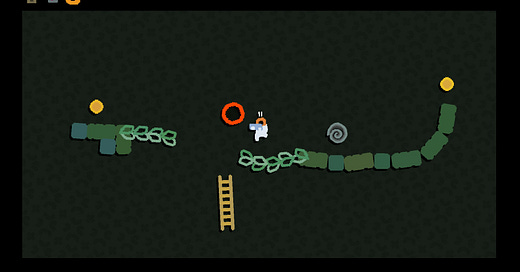Mosa Lina (2023) - Ramifications Of Radical Randomness
Stuffed Wombat on the consequences of a simple idea
Find the developer elsewhere: (Twitter, Blog)
It's the 17th of march, 2022. I got commissioned to create an absurd game.
At this point, Mosa Lina is a physics-driven platformer where you pick some tools, select a level and then try to beat it with your chosen equipment. I don't check whether the tools you select fit the level or not. That's what makes this game absurd: the levels don't have intended solutions, you just have to kind of sandbox your way to victory. Beating a level gives you money, which you can then use to buy new tools and unlock new levels. Standard game design stuff.
I don't like it. I hate doing the maths for stuff like this type of meta progression. How much does a tool cost? How much money do you earn for beating which level? Why does everything always lead back to simulated economies?
Then it hits me: Fuck it. Just make it all random!
I’d been thinking about randomness and video game structure for a long time, but now it all came together in a single moment. Remove the money, remove the choosing, remove the progression. Everything is random.
A run of Mosa Lina consists of a pool of 9 levels and a pool of 9 tools. The game gives you a random level and three random tools. If you beat the level, it gets removed from the game. If you don't, you draw a level and three tools again. When all levels have been removed, you win.
There are no safeguards. The game doesn't care if you get the same level 10 times in a row and you can play for hours without ever seeing a specific tool.
This radical randomness has some interesting ramifications.
When you fail a level, you can blame the randomness, but when you beat it (with randomly drawn tools that turned out to be really useful for that specific level) you get to feel really smart.
You might get sub-optimal tools for a level. Sure, you could just fail on purpose to reroll, but there is no guarantee that you will get a better combination of level & tools. So you might as well try to beat it anyways, leading to unexpected situations and the discovery of new use cases for tools that you would have otherwise never even bothered with.
Statistically speaking, the easiest levels are going to be the first ones to be removed from the pool. The harder a level is, the more often you will fail it, meaning that it gets put back into the pool. Statistically speaking, the final level will be the hardest one.
Now, on the other hand, the less levels there are in the pool, the more often you will see them. If there is only one level remaining, you will always draw it. If there are three levels remaining, then the chance that you will get the same level multiple times in a row is pretty decent.
So while the harder levels stay in the pool for longer, you also get to practise them more. Crucially, you also have a higher chance of getting a lucky draw of tools, meaning that as you play through a round, the game gets both easier and harder.
The important thing here is that those dynamics, cool as they are, were not completely intended at that moment on the 17th of March in 2022. Sure, I had some sort of idea about what the randomness would do, and I liked how that looked like, but the more complex dynamics only revealed themselves in the following days.
I released the first version of Mosa Lina for free in 2022. It would take another year until I'd pick this concept up again, expanding it into a full commercial game. The core dynamics never changed during development, but it took a long time before I was able to commit to them fully. Then, a few days before release, I decided to mix things up a bit more:
When you beat a level, the tools you have each get one point assigned to them. Statistically speaking, these are tools that you know how to use in many situations. After you’ve beaten 4 levels, the game picks one of the tools with the most points and removes it from the pool. The same thing happens again after you’ve beaten some more levels. This is intended to keep pushing you to experiment, by (statistically speaking) taking away the tool you can use the most consistently.
When there is only one level left, two (randomly chosen) sections are added to the sides of the level, making it either easier or harder to beat. Again, no safeguards. This adds the final spice to the conclusion of a run, giving you something to hope for and something to dread at the same time. Another random thing to conclude a radically random game.
What started as a rejection of conventional progression structures has turned out to be a relatively nuanced system that, despite being radically random, still produces game-design-y dynamics. Once that core had been found, the main work of Mosa Lina was to stay true to it, to resist the fear-based compulsion to muddy it with conventional game design “solutions”. Finally, the last touches to the game were just reinforcement of already existing patterns: Allowing you to blame the randomness for your failure, while also pushing you to experiment with tools that you'd have otherwise never even bothered to use.
Game Design Bounty
One day, I will get around to finally make the World’s Hardest Visual Novel.
Consider taking the Volume 1 reader survey!




